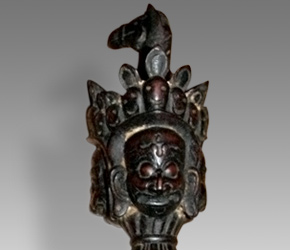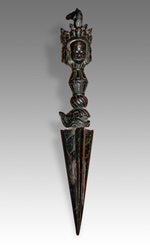Phurba, Kila or Ritual Blade
 |
|
"Phurbas are ceremonial tools to dispel evil. Phurbas are adorned with symbols to amplify this purpose – at the center of the Phurba is a symbol of spiritual firmness. The top of this Phurba depicts a guardian of the law"
Phurbas are known as magic daggers in Tibet, their country of origin. Phurba may be forged and made from metal, painted on carved wood, or simply illustrated on any surface. They can be understood as ceremonial daggers and are also called “nails.” Their purpose is to be used in rituals to expel demonic forces or diseases. Another function of the Phurba is to create an aperture between physical reality, the illusory world, and the real world which lies behind.
 |
|
At the center of the Phurba shown is a symbol called a Vajra or a Dorje, also known as a thunderbolt scepter. This particular symbol is used to dispel evil forces and hence came to symbolize spiritual forces or firmness of spirit. In the esoteric sects it symbolizes the victorious power of knowledge over ignorance. It is considered to annihilate spiritual poisons and to be an effective weapon against evil thoughts and desires. Like the Phurba it adorns, the Vajra is used to gain access to a state of grace which lies behind the illusion of physical reality.
At the top of the Phurba is a depiction of one of the Dharmapala, the guardians of the laws of Buddhism. Of ferocious and warlike appearance, the Dharmapala wage war on the enemies of the law, known as Dharma, and expel malevolent spirits. They are honored mainly in Tibet where they are worshiped individually, or in groups of eight. The particular Dharamapala depicted on the Phurba is most likely “Kuvera,” also known as Vaisravana, the guardian king, general of the Dharmapala who commands a great horse (the reason a horse is also depicted at the top of the Phurba), and a deity associated with wealth.
Download this Article: Phurba, Kila or Ritual Blade.pdf